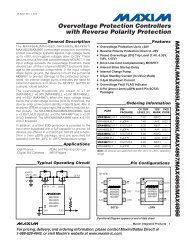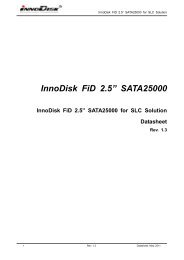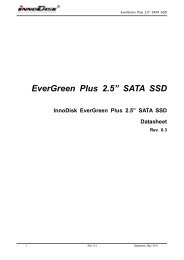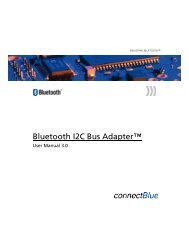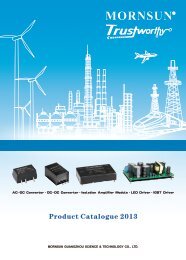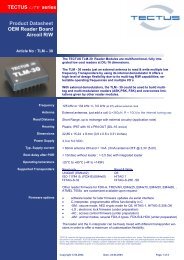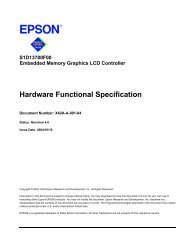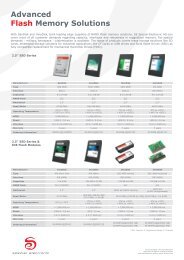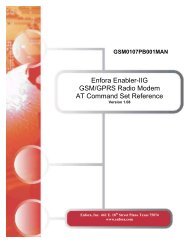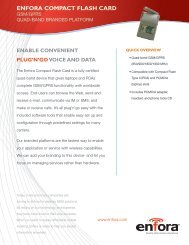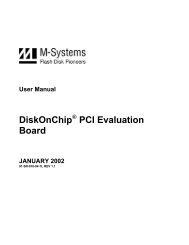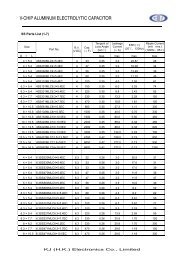Enabler II-G Assiste GPS Integration Guide - Farnell
Enabler II-G Assiste GPS Integration Guide - Farnell
Enabler II-G Assiste GPS Integration Guide - Farnell
Create successful ePaper yourself
Turn your PDF publications into a flip-book with our unique Google optimized e-Paper software.
Enfora <strong>Enabler</strong> <strong>II</strong>I-G<br />
Modem <strong>Integration</strong> <strong>Guide</strong><br />
6.6.10. Serial Interfaces & Handshake (Pins 11, 13, 15, 17, 19, 21, 23, 25)<br />
Pin Name Pin Number Signal Direction Description<br />
UART_TX 15 O Serial data output<br />
UART_RX 21 I Serial data input<br />
UART_RTS 13 O Request to send<br />
UART_CTS 11 I Clear to Send<br />
UART_DSR 17 I Data set ready<br />
UART_DTR 25 O Data terminal ready<br />
UART_DCD 19 O Data carrier detect<br />
UART_RING 23 O Ring detect output<br />
Please note that Serial interface is now referenced as a DCE and the<br />
naming of pins has changed since <strong>Enabler</strong> <strong>II</strong> products.<br />
The pin naming for TX/RX/RTS/CTS/DTR/DSR has been renamed to follow DCE conventions.<br />
The DTE device should match their input pins to the Enfora outputs and visa-versa. Additionally, there are<br />
AT commands that may need to be executed in order to insure proper operation. See the chart below.<br />
Pin Signal Signal Enfora Pin Enfora Pin Enfora AT<br />
Direction Name Number Command<br />
1 Carrier Detect (CD) from DCE UART_DCD 19 AT&C<br />
2 Receive Data (RD) from DCE UART_TX 15<br />
3 Transmit Data (TD) from DTE UART_RX 21<br />
4 Data Terminal Ready (DTR) from DTE UART_DSR 17 AT&D<br />
5 Signal Ground both<br />
6 Data Set Ready (DSR) from DCE UART_DTR 25<br />
7 Request To Send (RTS) from DTE UART_CTS 11 AT+IFC<br />
8 Clear To Send (CTS) from DCE UART_RTS 13 AT+IFC<br />
9 Ring Indicator (RI) from DCE UART_RING 23<br />
The key features of the UART in the modem mode are as follows:<br />
• 16C750 compatibility<br />
• Baud rate from 300 bits/s up to 115200 Kbits/s, autobaud<br />
• Configurable data format:<br />
Data bit: 5, 6, 7, or 8 bits<br />
Parity bit: even, odd, none<br />
Stop bit: 1, 1.5, 2 bit(s)<br />
• Hardware flow control RTS/CTS<br />
• Software flow control using XON/XOFF characters<br />
The <strong>Enabler</strong> <strong>II</strong>I-G module is designed to be used like a DCE device.<br />
Default settings are 8 data, 1 stop, no parity, and autobaud. DTR may be used to force the modem<br />
into AT command mode from online data mode (See AT Command Document, command AT&D).<br />
RTS and CTS may be used for hardware handshaking. DSR is always active (connected to ground)<br />
while the modem is on. RING may be used to alert the host to a variety of incoming calls.<br />
GSM0308PB001 48 Version 1.03– 7/17/2007



